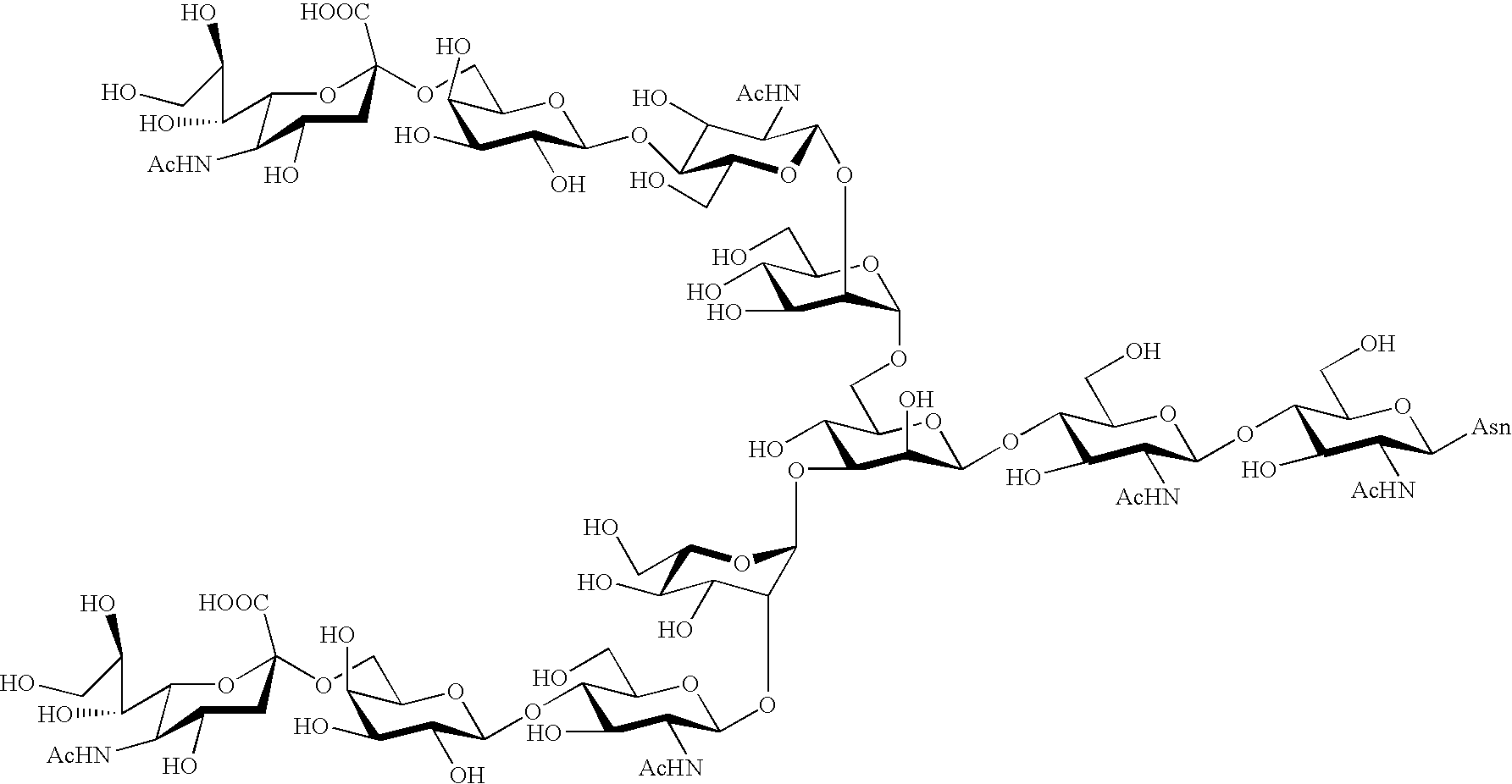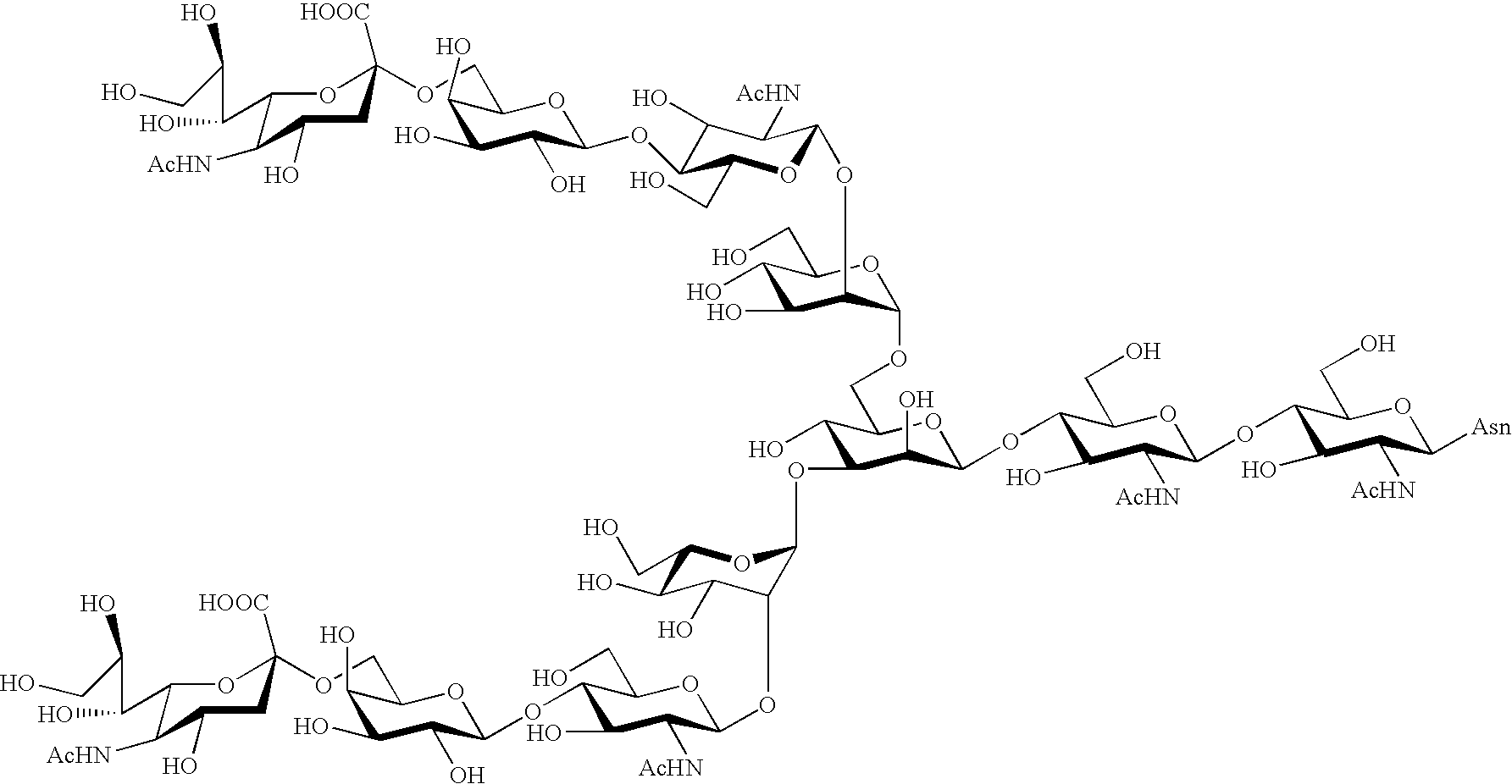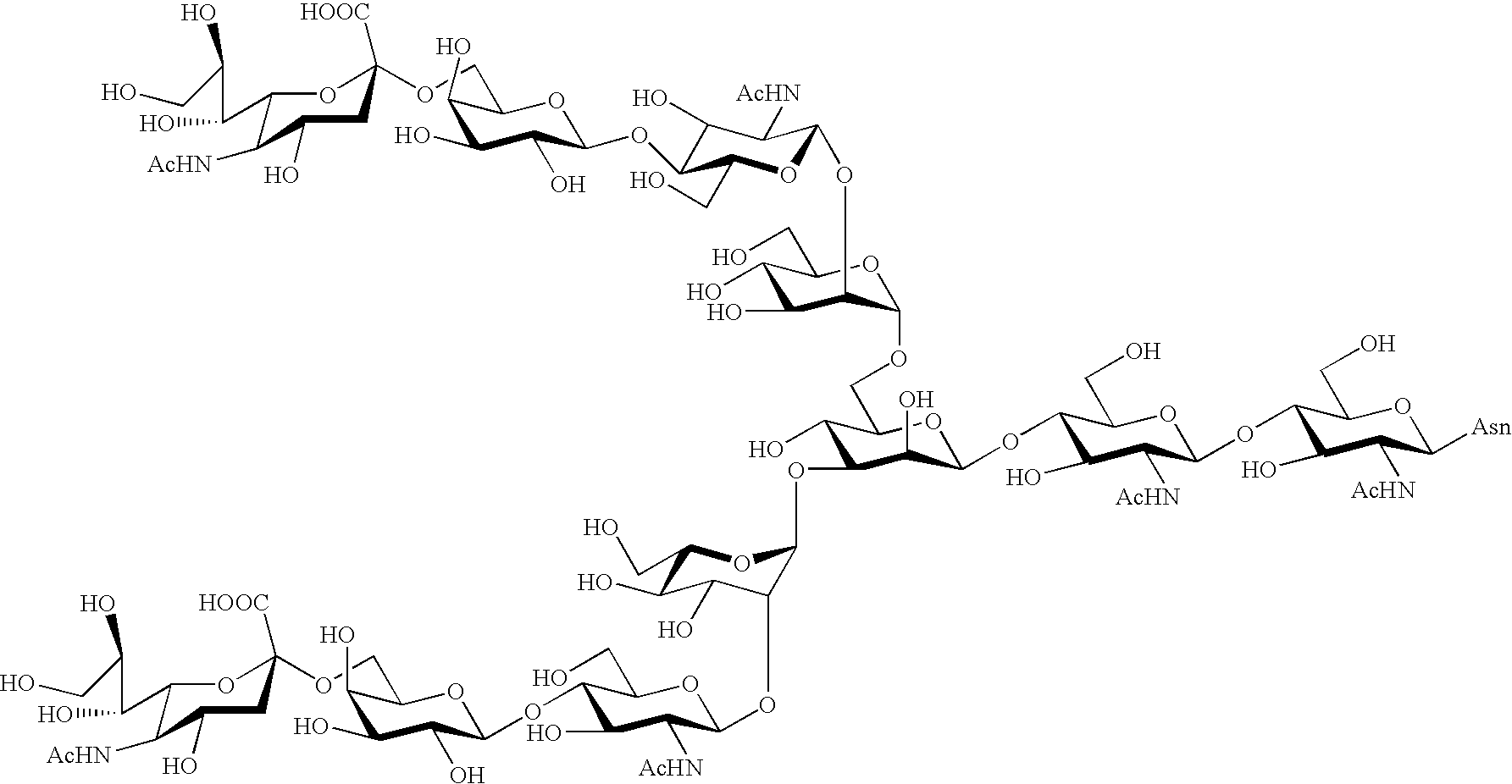Process for producing sugar chain asparagine derivative
a technology of asparagine and sugar chain, which is applied in the field of preparing sugar chain asparagine derivatives, can solve the problems of unable to obtain individual sugar chain derivatives, retarded development of gram scale studies, and difficulty in applying sugar chain derivatives in synthesis studies such as pharmaceutical manufactur
- Summary
- Abstract
- Description
- Claims
- Application Information
AI Technical Summary
Benefits of technology
Problems solved by technology
Method used
Image
Examples
example 2
Synthesis of Compounds 1, 2, 6 and 10
[0161] The compound 24 (609 mg, 261 .mu.mol) obtained in Example 1 was dissolved in 20.7 ml of water, and 13.8 ml of 0.1 N hydrochloric acid was added thereto. Immediately after heating this solution at 70.degree. C. for 35 minutes, the solution was cooled on ice, and a saturated aqueous sodium hydrogencarbonate was added thereto to adjust its pH to 7. The solution was lyophilized, and thereafter the residue was purified by gel filtration column chromatography (Sephadex G-25, 2.5 .phi..times.1 m, eluent: water, flow rate: 1.0 ml / min), to give 534 mg of a mixture of a compound 24, compounds 25 and 29, and a compound 33 each shown in FIG. 3. These four components were proceeded to the next step without being isolated from each other.
[0162] The physical data for the resulting sugar chain mixture are as follows.
[0163] .sup.1H-NMR (D.sub.2O, 30.degree. C.) 5.13 (s, Man4-H.sub.1), 5.12 (s, Man4-H.sub.1), 5.01 (d, GlcNAc1-H.sub.1), 4.94 (s, Man4'-H.sub....
example 3
Synthesis of Compounds 3 and 7
[0171] The mixture (224 mg, 97 .mu.mol) of the compounds 2 and 6 obtained in Example 2 and 24 mg of bovine serum albumin were dissolved in 22 ml of HEPES buffer (50 mM, pH 6.0), and Diplococcus pneumoniae-derived .beta.-galactosidase (1.35 U) was added thereto. This solution was allowed to stand at 37.degree. C. for 15 hours, and thereafter lyophilized. The residue was purified by HPLC (ODS column, 2.0 .phi..times.25 cm, eluent: 50 mM aqueous ammonium acetate:acetonitrile=85-:15, flow rate: 3 ml / min), and a compound 3 shown in FIG. 2 was eluted after 129 minutes, and a compound 7 was eluted after 134 minutes. Each of the fractions was collected and lyophilized. Subsequently, the fraction was desalted by HPLC (ODS column, 2.0 .phi..times.25 cm, eluent:water for a first 15 minutes, and applied to a gradient of water:acetonitrile of from 10:0 to 85:15 (volume ratio) for a period of from 16 to 30 minutes, and then to a gradient of water: acetonitrile from 8...
example 4
Synthesis of Compounds 4 and 8
[0176] A mixture (90 mg, 47.3 .mu.mol) of the compounds 3 and 7 obtained in Example 3 was dissolved in 8.1 ml of HEPES buffer (50 mM, pH 6.0) together with 8 mg of bovine serum albumin without separating the compounds from each other, and 2.88 U of a bovine kidney-derived .beta.-glucosaminidase (manufactured by Sigma-Aldrich Corporation, from bovine kidney) was added thereto. This solution was allowed to stand at 37.degree. C. for 18 hours, and thereafter lyophilized. The residue was purified by HPLC (ODS column, 2.0 .phi..times.25 cm, eluent: 50 mM aqueous ammonium acetate:methanol=65:35, flow rate: 3 ml / min), and a compound 4 shown in FIG. 2 was eluted after 117 minutes, and a compound 8 was eluted after 127 minutes. Each of the fractions was collected and lyophilized. Subsequently, the fraction was desalted by HPLC (ODS column, 2.0 .phi..times.25 cm, eluent: water for a first 15 minutes, and applied to a gradient of water:acetonitrile of from 10:0 to...
PUM
| Property | Measurement | Unit |
|---|---|---|
| time | aaaaa | aaaaa |
| pH | aaaaa | aaaaa |
| flow rate | aaaaa | aaaaa |
Abstract
Description
Claims
Application Information
 Login to View More
Login to View More - R&D
- Intellectual Property
- Life Sciences
- Materials
- Tech Scout
- Unparalleled Data Quality
- Higher Quality Content
- 60% Fewer Hallucinations
Browse by: Latest US Patents, China's latest patents, Technical Efficacy Thesaurus, Application Domain, Technology Topic, Popular Technical Reports.
© 2025 PatSnap. All rights reserved.Legal|Privacy policy|Modern Slavery Act Transparency Statement|Sitemap|About US| Contact US: help@patsnap.com



